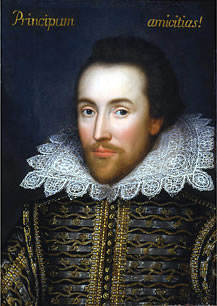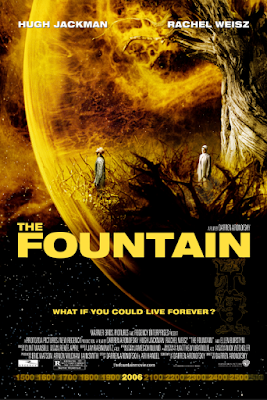"Now is the winter of our discontent...."
/ - - / - / - / - /
Now is the winter of our discontent
As Shakespeare often does, he uses a
trochaic inversion to begin the speech; otherwise, the line scans normally. Note how Shakespeare uses metaphor in this line and the one that follows, comparing the Yorkist ascension to the throne to a change in seasons. Discontent in this context can either denote "dissatisfaction" or "sorrow"; given Richard's character, it is more likely the former.
- / - / - / - / - /
Made glorious summer by this sun of York;
The completion of the metaphor is arguably a line of strict
iambic pentameter. This presumes that glorious is pronounced more like "GLOR-yus" than "GLOR-e-us," but the scansion would seem to indicate that intent. Sun is a pun in this line, playing upon the word son.
- / - / - / - / - /
And all the clouds that lour'd upon our house
In this straightforwardly
iambic line, Richard extends the metaphor by comparing the erstwhile reign of Lancaster to the gloom of a cloudy sky, playing upon the "sun of York" line that precedes it. Lour'd—Shakespeare uses the apostrophe to signal that "loured" should absolutely not be pronounced as "louréd"—is an archaism (from the Middle English louren; probably deriving from Middle High German luren "to lie in wait") that meant "to look sullen; to frown upon." The reference to "our house" refers primarily to the family of York, although it could also play off one of its meanings as "the management of domestic affairs" (referring to the War of the Roses).
- - / / - - - / - / -
In the deep bosom of the ocean buried.
This line demonstrates another common occurrence in Shakespeare's blank verse, in which he begins an
iambic line with a
pyrrhic followed by a
spondee. Sometimes it's used to reinforce meaning; other times, as it seems here, it merely adds a rhythmic changeup to the speech. The line also breaks up the iambic regularity by employing a
feminine ending (an extra unstressed syllable). Notice also how Shakespeare uses
ellipsis to omit the implied "are" in the line, helping to maintain the meter.
/ - - / / - - / - /
Now are our brows bound with victorious wreaths;
This line employs a pair of
trochaic inversions back to back. Victorious seems to warrant the same pronunciation as glorious in the second line above. As tasty and well known as this soliloquy is, its dramatic pitfall is that it's the opening speech of the play. Richard is serving as his own chorus here. So what we have over the course of the ensuing 23 lines is largely exposition of backstory and character. It may be well written, but it's still a character telling the audience everything they need to know to understand what's going to happen in the next five acts.
- / - / - / - / - /
Our bruiséd arms hung up for monuments;
Note in this line how the acute "e" (é) serves as another metrical road sign. Much like the apostrophe in "lour'd" signals the speaker not to pronounce the "ed" as an extra syllable, the é is the poet's way of ensuring that bruiséd is pronounced as two syllables rather than one. The phrase bruiséd arms in context can be read as a slight double entendre; it can refer to both weapons (as bruised's archaic meaning of "battered or dented") or limbs (as bruised's more traditional meaning of "contused or wounded").
- / - / - / - / - / -
Our stern alarums changed to merry meetings,
Another line, another
feminine ending. Alarums here is an archaic version of alarms, which derives from the Middle English alarme (alarom) via the Middle French alarme, which in turn derives from the Old Italian all'arme (literally meaning "to the arms"). Richard's comparison also employs
antithesis and
alliteration in this construction and the one that follows.
- / - / - - - / - / -
Our dreadful marches to delightful measures.
Like its predecessor, this line employs a
feminine ending; scanning the "to" as unstressed is debatable but makes sense given the construction and the sense of the line. This is also a great example of how Shakespeare tightly combines rhythm, sound, and rhetoric within an individual line. In addition to the stressed syllables of blank verse, Shakespeare uses both
antithesis and
alliteration to highlight the opposite ideas here. Dreadful contrasts delightful, and marches (denoting the drum-dominated compositions typically used to accompany soldiers in marching) contrasts measures (denoting more melodious and formal dance compositions)
/ / - / - / - / - /
Grim-visaged War hath smooth'd his wrinkled front;
The line begins with a
spondee, but is otherwise straightforward
iambic pentameter. This line begins a transitional turn in the speech, in which Shakespeare briefly employs personification to make war a humanized character. Richard will juxtapose that character against himself in the latter part of the soliloquy. Smooth'd in this context denotes "made even" with a connotation of "softened"; front means "forehead or brow."
- / - / - / - / - /
And now, instead of mounting barbéd steeds
In this strictly
iambic line, Richard builds upon the overall theme of the soliloquy. War is retiring his spurs, so to speak, and Richard doesn't seem particularly overjoyed by recent developments. Barbéd is a term used only in the two Richard plays, and refers to horses being "armed and harnessed."
- / - / - / - / - / -
To fright the souls of fearful adversaries,
The line scans as straight blank verse with another
feminine ending. Fright is used in the sense "to terrify," whereas fearful, rather than meaning "frightened" denotes "inspiring terror; dreadful."
- / - / - - - / - / -
He capers nimbly in a lady's chamber
This line hearkens back to the previous line of "dreadful marches to delightful measures" by invoking the metaphor of music and dance. To caper is "to leap or spring, in dancing or mirth." The effective use of imagery creates a diametric opposite to war and provides insight into Richard's view of recent events. Could there be any more disparate images than War as an armed horseman trampling his enemies and War as a courtier "in a lady's chamber" dancing?
- - - / - / - / - /
To the lascivious pleasing of a lute.
After beginning with a
pyrrhic, the rest of the line plays out in
iambs. Lascivious (from Middle English, from the Late Latin lasciviosus via Latin lascivus, "wanton") denotes "lewd, lustful." Pleasing here denotes "the pleasure; command or arbitrary will." Essentially War, who should be strewing death in battle, is instead dancing captivated by music. Note the word choice and sibilance in the middle of the line. Richard is bitter, and it's not just from current events, as betrayed by the turn that the soliloquy takes at this point.
/ / - / - / - / - /
But I, that am not shaped for sportive tricks,
The heavy stresses of the initial
spondee help to signal the aforementioned shift in subject. Richard's cynicism turns away from its disdain for peace and waxes introspective. This is where Shakespeare alludes to Richard's deformities, most notoriously the hunchback. Sportive means "amorous, wanton" in context. Trick (deriving from the French trique= "trick, deceit, treachery, cheating" via Latin tricari = "be evasive, shuffle") is used in its sense of "deception or mischief." The phrase is highly ironic given Richard's courtship of Anne in the next scene.
- / - / - / - / - /
Nor made to court an amorous looking-glass;
Depending upon the scansion and pronunciation, one could read the line as five
iambs or as four
iambs with an
anapest substitution in the fourth foot. The natural tendency seems to elide the middle vowel sound so that the word sounds like "AM-rus," which is reflected above. Note how "court an amorous looking-glass" implies a bit of self-loathing in Richard's psyche, especially when coupled with Richard's lines in the second scene of Act I ("I'll be at charges for a looking-glass"). It doesn't take a therapist to decipher the body image issues at work here.
/ - - / - / - / / / - -
I, that am rudely stamp'd, and want love's majesty
Metrically, this 12-syllable line is something of a puzzler. It could read as an
alexandrine, but Shakespeare's overall body of verse doesn't really employ
hexameter as a bona fide metrical variant. There are plenty of unavoidable stresses in the line, and it makes for some wildly speculative scansion toward the end. Rudely stamp'd means "roughly or crudely fashioned" here, while want means "lacking" rather than "desiring or feeling a need" given Richard's character.
- / - / - / - / - /
To strut before a wanton ambling nymph;
In contrast with this line's predecessor, the scansion here is textbook
iambic pentameter. Richard shows more disdain for love and beauty by dismissing womankind as a "wanton ambling nymph" (wanton = "lustful," ambling = "moving affectedly; dancing," and nymph = "a beautiful woman").
/ - / - / - - / - / -
I, that am curtail'd of this fair proportion,
This line seems to scan as
trochee/
trochee/
trochee/
iamb/
iamb with a
feminine ending. The only stress that could go another way is the upbeat on "am"; everything else is dictated by natural emphasis. Curtail means "to lessen" (literally "to shorten" from curtal, "to dock an animal's tail" via the Middle French courtault). Fair denotes "pleasing or favorable" in this context, although its proximity to "cheated" in the next line brings to mind the connotation of "due or just" as a subtext. Proportion is synonymous with "shape."
/ - - / - / - / - / -
Cheated of feature by dissembling Nature,
As with most lines, natural inflections dictate the stresses here with the arguable inclusion of "by" as a strong beat. Note how the Richard's word choice in cheated implies that he deserves better. Dissembling (from Middle English dissymblen, deriving from the Middle French dissimuler via Latin dissimulare "to simulate") means "putting on a false face; effecting a pretence to conceal facts, intentions, or feelings" and also reflects a man at odds with Nature.
- / - / - / - / - /
Deformed, unfinish'd, sent before my time
In his line of straight
pentameter, Richard states that he was prematurely born, which would explain some of his infirmities. On the other hand, Richard was known in his day as a sturdy, brave swordsman, which would lead one to believe that he wasn't so deformed after all.
- / - / - / / / - /
Into this breathing world, scarce half made up,
The "scarce half" comprising the
spondee in the fourth foot could read equally well as an
iamb. Scarce is synonymous with "barely" in context; the line builds on Richard's assertion that he was a premature baby.
- / - / - / - / - - -
And that so lamely and unfashionable
This line presents another metrical irregularity; Shakespeare rarely ends a line with a five-syllable word, much less on a three-syllable downbeat such as this. After four iambic feet, there are two ways to view the end of "unfashionable": either as a
pyrrhic followed by a
feminine ending, or the more controversial (among critical scholars, at least) interpretation of a tribrach—a trisyllabic foot consisting of three unstressed syllables. The reason that many scholars contest the very existence of the tribrach is that there always seems to be an alternative scansion for it, no matter the context (such as, in this case, scanning it as a
pyrrhic in a line with a
feminine ending). Building on the theme of the previous two lines, Richard reflects bitterly upon his deformities.
- / / - / - - / / -
That dogs bark at me as I halt by them;
The stresses here could fall a couple of ways. The swing stress here is "me"; I've scanned it as an upbeat because it's hard to pull off four consecutive unstressed syllables in the middle of a line. Halt means "to limp."
- / - - / / - / - /
Why, I, in this weak piping time of peace,
Note the interesting play of the long-voweled "I" sound in this line. Piping time is another contrast of war and peace in this speech; the pipe has replaced the fife that accompanies soldiers. Richard hearkens back to the beginning of the speech to tie his disdain for peace in with his disdain for his stature.
- / - / - / - / - /
Have no delight to pass away the time,
Because Richard is not suited for love by appearance or nature, he can indulge in none of the delights of peace. All this part of the speech is leading up to his eventual rationale for his misdeeds, "And therefore, since I cannot prove a lover/To entertain these fair well-spoken days/I am determinéd to prove a villain/And hate the idle pleasures of these days." Richard, in addition to being a thoroughly rotten human being, is suffering from that ageless affliction of being a man of war in a time of peace.
- / - / - / - / - /
Unless to spy my shadow in the sun
There's little more to say about lines of regular
iambic pentameter, except that this makes the ninth line out of the 27 that comprise this speech that are strictly
iamb/
iamb/
iamb/
iamb/
iamb in construction. That makes a third of the selection. The remaining two-thirds exhibit some form of variation. Even early in his career, Shakespeare knows that line after line of unbroken blank verse would lull even the groundlings to sleep. This line also demonstrates Richard's self-aware sense of humor; it's as if he steps out of his soliloquy for a moment to share a joke about it with the audience. It's sort of the Elizabethan equivalent of acting into the camera.
- - / - - / - / - /
And descant on mine own deformity.
The scansion of the line largely depends on how one pronounces descant (meaning "to comment"); most dictionaries show either syllable as taking the stress, and we don't know how the Elizabethans would have treated it. The above scansion, however, makes the line a little less sing-song when following the previous one. From this point forward, the exposition inherent in the speech shifts from revealing setting and character to revealing the plot to come. Richard casts himself as villain by his own admission, and Shakespeare's words in his mouth ensure that history will always remember him that way first.














